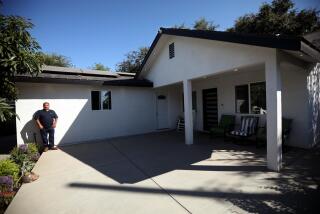White-Latino Lending Gap Grew, Study Says
In a sign that the homeownership gap between whites and Latinos is widening in Southern California, conventional home loans to Latinos at all income levels in Los Angeles County grew by 6% from 1995 to 1999, while comparable loans to whites shot up 81%, according to a report to be released today by a coalition of community and business organizations.
The latest statistics are striking because the Latino population in Los Angeles County grew by 456,000 between 1995 and 1999, while the white population shrank by 164,000, according to the report.
Today’s Greenlining Institute report shows that Latinos make up almost 45% of the population in Los Angeles County and one-third of the population statewide, yet they secured only 10% of all conventional home loans in 1999.
The Greenlining Institute, an alliance of church, consumer, civil rights and small-business groups based in San Francisco, issued its study of conventional home loans three weeks after a report on African Americans revealed similar home mortgage lending results.
The report emphasized that the homeownership rate gap between Latinos and whites is not the result of discrimination but is the result of increasingly steep home prices, as well as community outreach problems and local anti-growth policies.
“Pretty soon, we’re going to see the complete lack of homeownership among Latinos in Los Angeles because the difference between their income and housing prices is so great,” said Robert Gnaizda, general counsel for the Greenlining Institute. “The majority of the region’s population will be left out of homeownership.”
The report, based on Federal Reserve data, included statistics from the state’s largest banks, including Chase, Citibank, Wells Fargo, CalFed, Washington Mutual, World Savings, Bank of America, Union Bank and Sanwa Bank.
The study included data on all regulated and unregulated lenders statewide but excluded data on government-backed loans, for which it says terms are less favorable for borrowers.
In South-Central Los Angeles, where the majority of the 1.3-million population is Latino and African American, the largest lenders made 377 loans to Latinos of all income levels, 182 of which went to Latinos earning $41,000 a year or less. Countywide, they made 5,242 total loans to Latinos, 1,381 of which went to Latinos earning $41,000 or less.
In Orange County, where 29% of the population is Latino, only 7% of all conventional home loans went to that group, according to the institute. Only 1,211 Latinos earning less than $56,000 received conventional home loans in the county, Southern California’s most expensive housing market.
Washington Mutual jumped ahead of the other eight banks in lending to Latinos in 1999, with 2,115 of the 5,242 total loans going to Latinos in Los Angeles County. The bank also led in loans to lower-income Latinos.
Bank officials agree that a lending gap exists between Latinos and whites, but they stress that even their most aggressive outreach programs do not address the region’s pressing affordability problem.
Dan Hanson, director of affordable housing for Wells Fargo Bank in Los Angeles, said government agencies, banks and nonprofit organizations must pool their resources to increase the region’s housing stock and to communicate better with the Latino population about home-buying opportunities.
“We want to get the word out to [minorities] about how to apply for a loan,” Hanson said. “The bank created my position to try to really make a difference and help with education issues.”
The institute report calls for revisions in state and federal homeownership tax policies that would cut the costs of homeownership in half in low-income communities.
More to Read
Inside the business of entertainment
The Wide Shot brings you news, analysis and insights on everything from streaming wars to production — and what it all means for the future.
You may occasionally receive promotional content from the Los Angeles Times.










